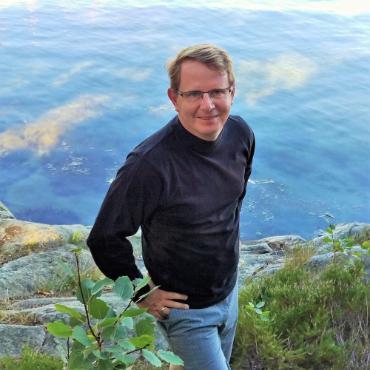This story originally appeared in Lawyer, Spring 2020.
Vincent Bryan III ’90 has developed a path to clean energy through a unique technology

If fish rode roller coasters, it might look like the device that Vincent Bryan III ’90 invented. In fact, a video of his “salmon cannon” went viral last summer as millions of viewers watched fish hurtling through misted tubes.
“Clearly, this is the greatest object that has ever been invented,” comedian John Oliver remarked, featuring the salmon cannon on Last Week Tonight in 2014.
But despite the playful moniker and viral fame, this invention has a serious purpose: it could be the key to the long-term viability of salmon and other critical fish species while helping to generate clean energy.
Bryan, the entrepreneur and lawyer behind this innovative technology, believes that hydropower is a necessary part of a renewable power grid that can help society avert the worst effects of climate change. Dams create emissions-free energy, but unfortunately, they also block fish migrations, most notably salmon species that use Pacific Northwest rivers to spawn.

“There are 85,000 dams in the United States, yet only 2,500 generate power,” he said. “Because the federal government, under the auspices of the Endangered Species Act, requires dams to implement some kind of fish passage, it is often too costly to add power generation capability.”
That’s where Bryan’s “Whooshh Passage Portal,” the fully automated successor to the salmon cannon, could revolutionize hydropower economics. It’s significantly cheaper to implement than traditional fish ladders – the prevailing technology – and it’s much more effective at keeping fish healthy. It’s hard to believe that such a game-changing innovation wasn’t developed anywhere near fish. It actually started in an apple orchard.
Bryan, who hails from an entrepreneurial family, had developed a machine to partially automate apple harvesting as a solution to a labor shortage at his family’s Eastern Washington orchard. The technology relied on water to decelerate the apples gently as they exited tubes. Unfortunately, he soon discovered it couldn’t be used due to a United States Department of Agriculture regulation, designed to prevent bacterial exposure, which bans any tree fruit, once picked, from being submerged in water in the field.

This put him and his team at a crossroads. “We asked ourselves, ‘Was there another problem where this technology could be put to use?’ And the answer was fish,” he said. Seven years ago, they completely shifted focus, changing the name from Picker Technologies to Whooshh Innovations, coined for the sound fish make as they transit through the migrator tubes that are a key element of the system.
Because Bryan and his team entered an even more highly regulated industry than agriculture, his legal training has proven invaluable.
“It’s a huge challenge to introduce new technology to a river that hosts endangered species, because the Endangered Species Act has no mechanism that allows for it. If you touch, delay, or change the migration of a fish, you are technically in violation for something called an incidental intake,” he said.
For this reason, the technology’s adoption has been slowed. Regulations also make the business model, and the company’s long-term success, somewhat risky.
“This is where my law degree is useful,” Bryan said. “If you really understand the rules, you can be more creative, because you know what you need to do to avoid unnecessary risk. It’s not that you can’t do something, it’s about how you go about doing it but staying within the confines of the rules.”
This is the type of role he had in mind when he graduated from Seattle U Law. “I didn’t want to tackle a problem that had already spiraled out of control. The real value and creativity could be in avoiding that result. That’s where I wanted to be.”
Stints in private practice and as corporate counsel for Adobe, along with the experience of helping his family run a variety of ventures, have given him the expertise to guide Whooshh as its CEO. From the initial startup phase, the company is now steadily growing. With 15 employees and five consultants/contractors, Whooshh has deployed 20 of its systems in Northwest rivers and other parts of the U.S., as well as in Sweden and Norway. The earliest adopters have been native tribes in Washington, and initial results have been encouraging.
Fish ladders – a series of ascending pools – have been the preferred solution in the Northwest to allow fish to pass around dams. But ladders have significant downsides: they’re expensive, and they allow invasive species to pass through and ultimately compete with and crowd out native species.
Bryan’s innovation solves these problems. Here’s how it works: Fish swim into the system, slide under a proprietary fish recognition scanner (which sorts out invasive species and allows native fish to pass), glide (or “whooshh”) through flexible misted tubes, and finally return into the water and continue upriver, all in a few seconds.
“This technology demonstrates a novel approach in an area that has not seen a whole lot of innovation. It has a lot of potential advantages, including flexibility on where and how to deploy. It still needs more study, but the results I have seen show a lot of promise,” said Alison Colotelo, a project manager with Pacific Northwest National Laboratory.
In all, Bryan has secured $20 million in investments and grants and $250 million in financing. Looking forward, his goal is to accelerate the system’s deployment on a much larger scale. Yet, even with his system’s value proposition, he’s discovered that entrenched methods can be difficult to change.
This is where the salmon cannon videos, humorous as they are, serve a purpose. Their viral popularity has helped Whooshh sell the technology’s value directly to citizens. Bryan said: “With the public behind the technology, it reduces the risk for politicians. What this has done is open up a vision for what’s possible today, which wasn’t imagined even a few years ago.”
